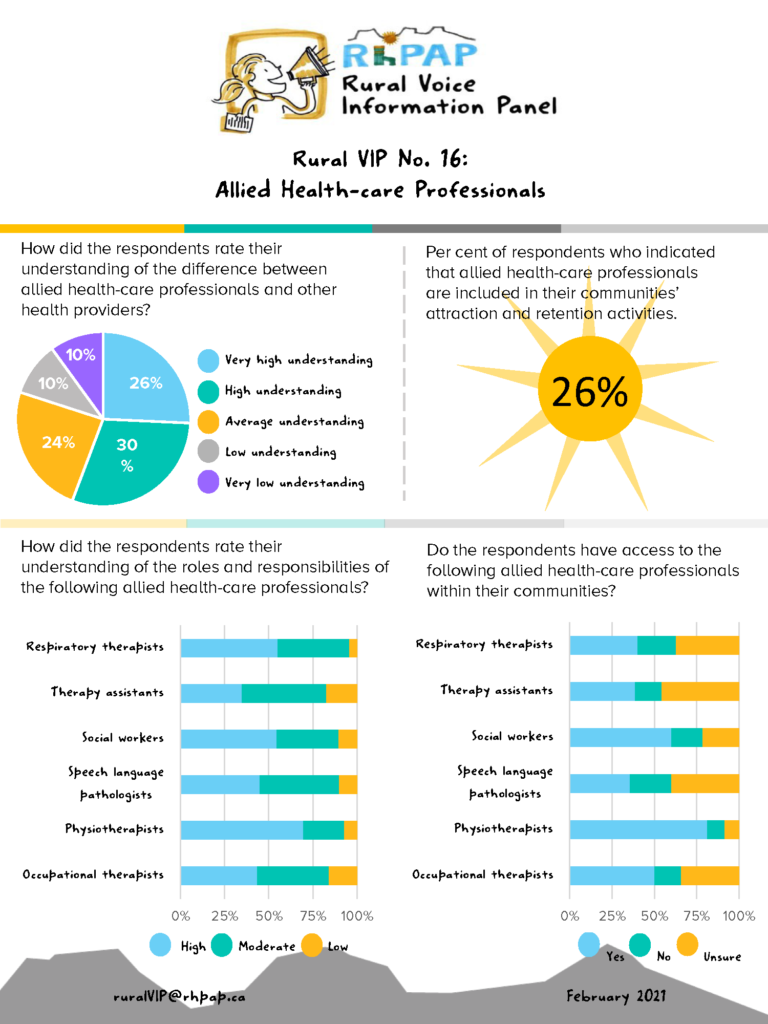This month, we asked the 224 members of the Rural Voice Information Panel (Rural VIP) about allied health professionals in their communities. Specifically, we were seeking to determine what rural Albertans know about allied health professionals and whether these professionals are included in their community’s attraction and retention activities.
Allied health professionals are health-care providers with formal education and training who are credentialed through certification, registration, or licensure. According to Alberta Health Services, the following are the allied health professionals most likely to be found in a rural Alberta community: respiratory therapists, therapy assistants, social workers, speech language pathologists, physiotherapists, and occupational therapists.
These professionals collaborate with physicians, nurses, and others to form interprofessional health-care teams to deliver high quality patient care services for the identification, prevention, and treatment of diseases, disabilities, and disorders.
Key findings

More than half of respondents indicated that they have a high understanding (56 per cent) of the difference between allied health professionals and other health providers as compared a fifth of respondents who reported having a low understanding (20 per cent). Similarly, these respondents were also more likely to have a high understanding of the roles and responsibilities of the identified allied health professionals.
Most respondents indicated that they have access to these allied health professionals within their community. The most accessible allied health professionals were physiotherapists, with 81 per cent of respondents reporting they had local access to one. Respondents were much less certain about access to other allied health professionals; approximately one-third were unsure whether they had any local access to other allied health professionals.
In terms of attraction and retention, twenty-six per cent of respondents indicated that their community currently involves allied health professionals in these activities. Examples of this involvement includes the participation of these professionals in skills days and weekends, sending them welcoming cards, and including them in welcoming activities and appreciation events.
When asked about the information they would like about allied health professionals, respondents were interested in more information on the community need, professional roles and responsibilities, and the allocation and recruitment structure for these professionals.
As one Rural VIP member noted: “I think a broader public education push on all aspects of what is a health-care provider… as [right now,] nurse and doctors seem to [be] where many people stop when thinking of health professionals.”
Next steps
The results from this survey suggest that rural communities, represented by the Rural VIP panel, already have a high understanding of allied health professionals; However, with respect to access, only about half of the respondents reported local access to the allied health professionals. Despite this lack of access, most communities represented by survey respondents do not include allied health professionals in their attraction and retention activities. RhPAP will use this information to inform future programming and educational materials.
In addition, each month, RhPAP shares learnings and feedback with Alberta Health and the RhPAP Board of Directors, who represent the following organizations: Alberta Health Services, the Alberta Medical Association, the College of Physicians and Surgeons of Alberta, Rural Municipalities of Alberta, and the College and Association of Registered Nurses of Alberta. We may also share this information with other relevant health professional organizations for their consideration.
